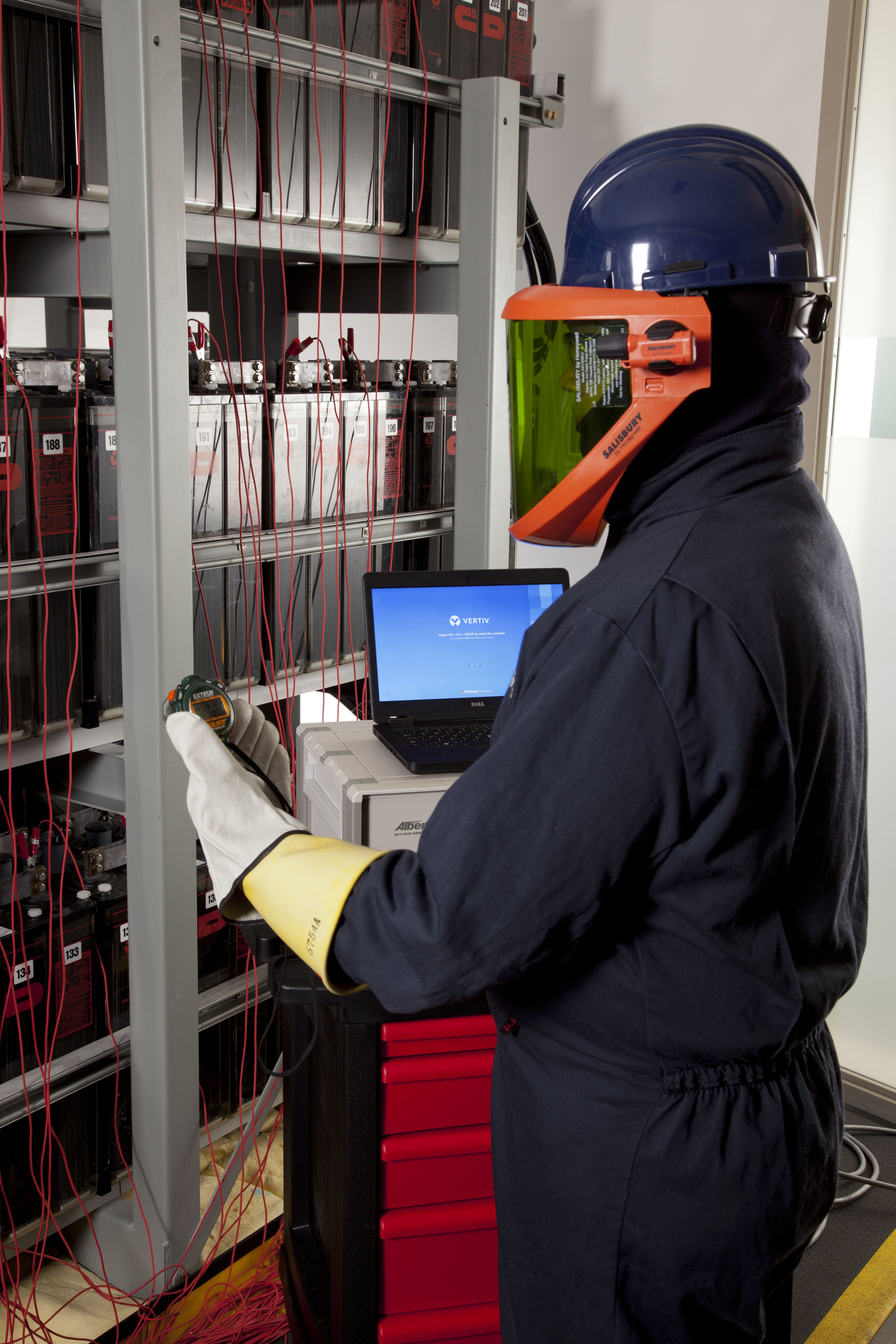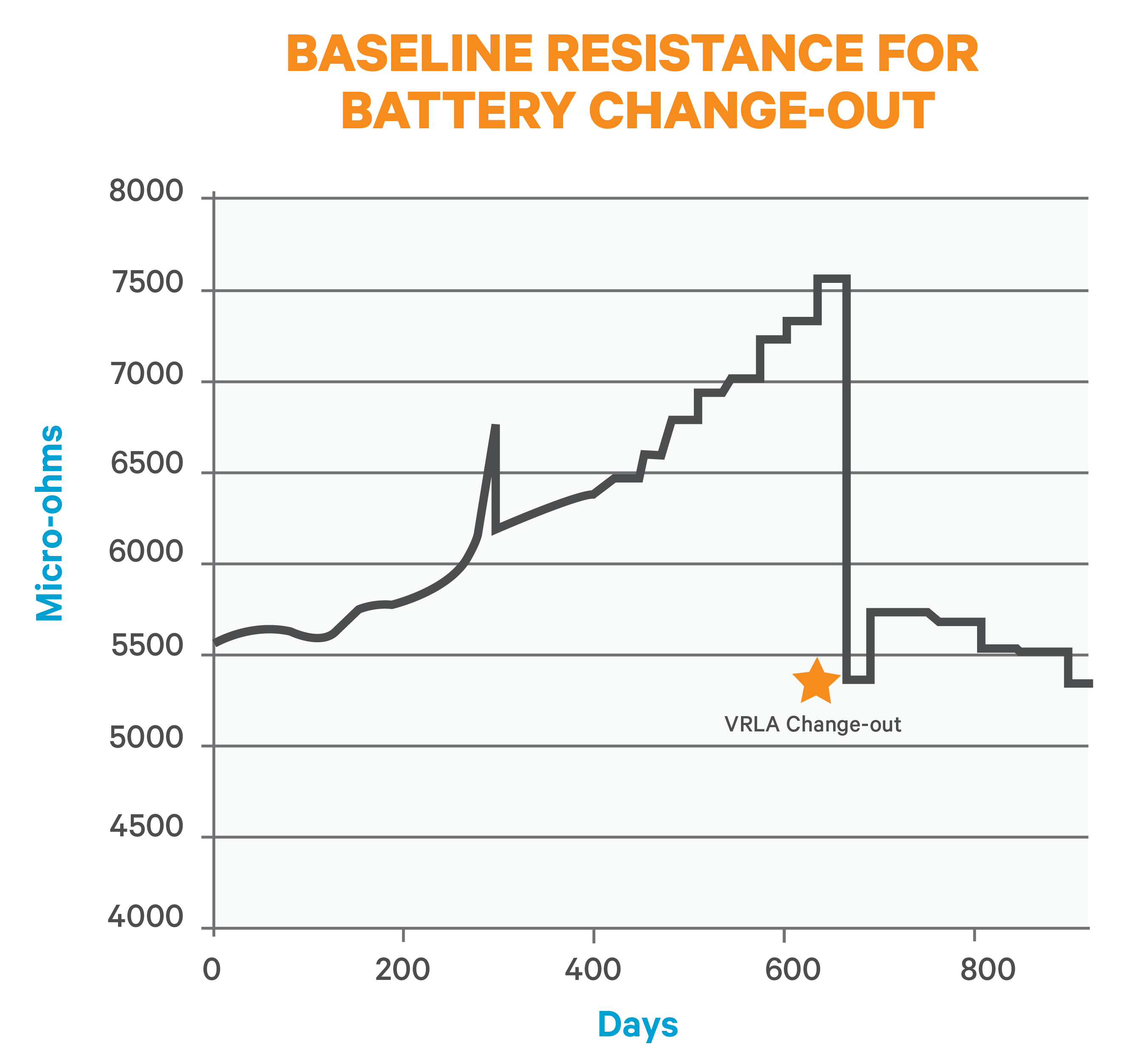Commentary Contributed by Brandon Schuler, Supervising Engineer, DC Services • Vertiv’s Electrical Reliability Services
When it comes to the electrical systems in industrial and commercial facilities and power plants, total system reliability is the top priority. That requires an approach to electrical system service that encompasses both the AC and DC power systems.
These two systems play an interconnected and equally critical role in ensuring overall reliability. Daily production and the protection of equipment requires seamless interaction between the two systems. DC power enables the AC uninterruptible power supply (UPS) to bridge short power interruptions that could disrupt production while DC-powered protective relays provide critical overcurrent protection to transformers, turbo generators, motors, and other AC systems to prevent costly damage and downtime.
While both the AC and DC systems are critical to continuous operation, the DC power system is more vulnerable to unexpected failure because it is comprised of batteries, which have a shorter lifespan and age more unpredictably than AC system components. A failure of a single battery cell can cause the disruption of systems supported by that battery string.
As a result, batteries represent the weak link in the power system chain. Strengthening this weak link through a well-designed and disciplined approach to battery maintenance is one of the most cost-effective measures that can be taken to ensure reliability and prevent costly downtime in industrial and commercial facilities and power plants.
Design Life Versus Service Life
It’s well known that batteries are subject to wear and aging faster than other electrical system components. Still, misunderstanding battery life expectancy is common and stems from confusing battery design life with battery service life.
Battery design life is specified by the manufacturer and takes into account cell design and battery aging under controlled conditions in the manufacturer’s laboratory, which rarely, if ever, match real-world operating conditions.
Battery service life considers how application, installation design, changing operating conditions, and maintenance practices impact battery aging. Service life is almost always shorter than design life and often by a significant amount. How batteries are handled, the environment in which they operate, and inadequate maintenance and replacement practices can all lead to premature aging and unexpected failure.
Proper battery maintenance not only prevents unexpected failures, but can also extend battery service life to reduce the number of replacements required. An effective maintenance program includes regularly performing the following activities:
- Visual and mechanical inspection
- Resistance testing
- Recording of float and supply voltage measurements
- Electrolyte inspection
- Recording of gravity readings
- Battery bank capacity testing
- Proactive replacement
- Charger and rack integrity checks
- Monitoring
 Inspection and Testing
Inspection and Testing
For industrial and commercial applications, battery manufacturers typically cite adherence to standards from the Institute of Electrical and Electronics Engineers (IEEE) as a requirement to maintain a valid product warranty. Similarly, power plants are expected to meet requirements from the North American Electric Reliability Corporation (NERC). These standards serve as the foundation for consistent, preventive battery maintenance.
The IEEE standards, which vary based on battery type, provide recommended practices for maintenance, testing, and replacement of batteries for stationary applications. They include the frequency and type of inspection or measurements that need to be made to validate the condition of the battery.
For vented lead-acid (VLA) and valve-regulated lead-acid (VRLA) batteries, inspections are required monthly, quarterly and annually. The measurements to be taken at each interval, such as string/cell voltage and battery float charging current, are specified in the standards.
In general, the more frequent the inspection or testing intervals, the better the program. Gathering data on a more regular basis supports the ability to trend battery performance, which can be a valuable tool in predicting failure and extending battery service life.
Recommendations for capacity testing of VLA and VRLA batteries are also very similar. Both should be tested at installation, during periodic intervals (no longer than 25 percent of the expected service life), and annually when the battery shows signs of degradation or has reached 85 percent of the expected service life.
The IEEE standard also suggests that VRLA batteries be tested when internal ohmic values have changed significantly between readings or physical changes have occurred. Degradation is indicated when the battery capacity drops more than 10 percent from its capacity on the previous test or is below 90 percent of the manufacturer’s rating.
Batteries kept in service beyond expected service life are at increased risk for failure. Performing regular inspections and testing allows potential issues such as high resistance or corrosive inter-cell connections to be identified and corrected before they impact battery life.
Continuous Monitoring
While following IEEE recommendations is the best practice and required to maintain warranty protection, everyday pressures and resource limitations can make it difficult to accomplish this on a consistent basis. It’s easy to put off battery inspections because the problems created by missed inspections aren’t immediate. However, problems inevitably arise that often extend beyond the battery. For example, one company relied on their UPS to operate an emergency relief valve, but when the supporting DC power system failed, the valve did not close causing a dangerous chemical release. In another example, failure of DC system batteries supporting a call center knocked out some emergency services including the ability to field 911 calls. The pending battery failure in each of these cases would have likely been discovered with a timely inspection, or better yet, with remote monitoring.
A cost-effective solution, remote monitoring can reduce the need for manual battery inspection and can help ensure ongoing battery health. Instead of waiting for an inevitable failure or replacing batteries prematurely to prevent problems, a battery monitoring system provides continuous visibility into cell voltage, internal resistance, cycle history, overall string voltage, current, and temperature.
Monitoring systems provide an accurate picture of battery health without discharging batteries by measuring the internal resistance of all the cells in the battery string. As the battery ages and loses capacity, the resistance of a cell increases. In an aged string, a substantial increase in the resistance of one cell should be considered end of life for the battery string.
In addition to identifying batteries approaching failure, the information gained from battery monitoring can help maximize battery life. VRLA batteries are sensitive to temperature and float voltage settings. A battery monitor can provide ambient temperature, cell voltage, internal resistance, and data logging of the batteries monitored, allowing these conditions to be better controlled to minimize degradation.
Remote Service
Another benefit of a battery monitoring system is its ability to enable remote service, removing the burden of battery maintenance from in-house staff and expanding the value of the monitoring system. Remote services organizations provide both the dedicated resources and specialized expertise to perform real-time diagnosis of potential problems and near instant notification when a problem occurs.
When performance data falls outside of established parameters, an alert is transmitted to remote power system engineers and/or product experts who assess the situation through data analysis. This, in turn, can generate a work order to inspect, repair, or replace the part that caused the alert, or can initiate a notification to key personnel. In either case, problems that have the potential to result in lost production or damage can be avoided.
In addition, a dedicated service organization can often identify larger infrastructure issues based on battery type or application. Because they have access to data from multiple locations, they can spot potential problems caused by a certain part or component and can tailor maintenance activities based on the specific performance of certain batteries across a wide range of sites.
A remote monitoring service provider may also have engineers on staff to systematically analyze data in real time. Through this process they could, for example, recognize if an emergency generator has started and is providing power, but at the wrong time and for the wrong reason. They would have the data to not only identify this issue, but also pinpoint the probable cause.
 Battery Replacement
Battery Replacement
IEEE standards recommend replacing the battery if its capacity is below 80 percent of the manufacturer’s rating. The replacement should be made as soon as these conditions are observed during testing or when identified by the monitoring system.
Depending on the skill level of in-house staff, it may be wise to have replacements performed by specialists to avoid any problems. If a battery is connected improperly following replacement, it will affect the entire string. In addition, physical characteristics, such as plate condition or abnormally high cell temperatures, should be observed. These conditions can often guide decisions on whether the complete string or an individual cell should be replaced.
Baseline resistance for the new battery or string should also be recorded. While it is common to take these measurements immediately following installation, Vertiv research shows delaying the baseline measurement for at least 90 days will provide a more accurate measurement. Resistance tends to drop following installation and then level off and a baseline measurement taken too soon after installation can be off by as much as 25 percent.
On average, baseline values for most batteries should be established after they have been in service anywhere between six and nine months. Comparing the changing features of the battery data against an accurate baseline helps identify performance patterns for better forecasting of a battery’s end of life.
Mobile DC Power Unit
Performing battery maintenance can pose a risk to operations. If the utility source drops off line or suffers a power dip while batteries are being serviced, the protection and other business-critical systems may fail to operate as intended, or the entire load may be dropped resulting in costly and potentially disastrous results.
For many critical facilities, such as chemical plants, refineries, or power plants, disabling the battery system to perform required inspections, tests, and component replacements is not an option. Having access to a temporary power solution is necessary in these situations.
Mobile power systems provide dependable, temporary power with the added convenience of timely, on-site services. By working with a service provider with a mobile DC power option, facilities are able to support and back up critical loads, ensuring no business interruptions during battery maintenance or replacement.
Integrating DC Power into a Comprehensive Maintenance Strategy
As more and more emphasis is placed on availability and reliability of critical power systems, the importance of protection and backup systems, and the batteries they depend on, cannot be overemphasized. Integrating DC power maintenance into a total systems approach is essential to maximizing uptime for industrial and commercial facilities and power plants.
The first step in ensuring availability is implementing a testing and maintenance program that is compliant with IEEE and/or NERC guidelines. In most cases, remote battery monitoring will prove to be the most cost-effective approach to ensuring the necessary visibility for identifying potential failure conditions and prolonging battery life.
Regular maintenance and monitoring enable the replacement of batteries and other components based on performance trending, instead of by age. Additionally, utilizing a mobile DC power solution during system maintenance helps ensure the backup power system can continue to function during maintenance and testing.
DC power systems, when well-managed, protect critical operations, help facility managers ensure the reliable operation of their total power system, and help businesses avoid the high cost and detrimental impact of unplanned downtime.
 Brandon Schuler joined Vertiv’s Electrical Reliability Services team in 2014 and has 20 years of experience in performing and managing electrical/electronics testing and maintenance. Brandon has earned several factory-level certifications and is a veteran of the United States Air Force. As an expert electrical technician and an experienced team leader, Brandon helps customers get the most out of the electrical assets that support their critical processes and systems.
Brandon Schuler joined Vertiv’s Electrical Reliability Services team in 2014 and has 20 years of experience in performing and managing electrical/electronics testing and maintenance. Brandon has earned several factory-level certifications and is a veteran of the United States Air Force. As an expert electrical technician and an experienced team leader, Brandon helps customers get the most out of the electrical assets that support their critical processes and systems.







